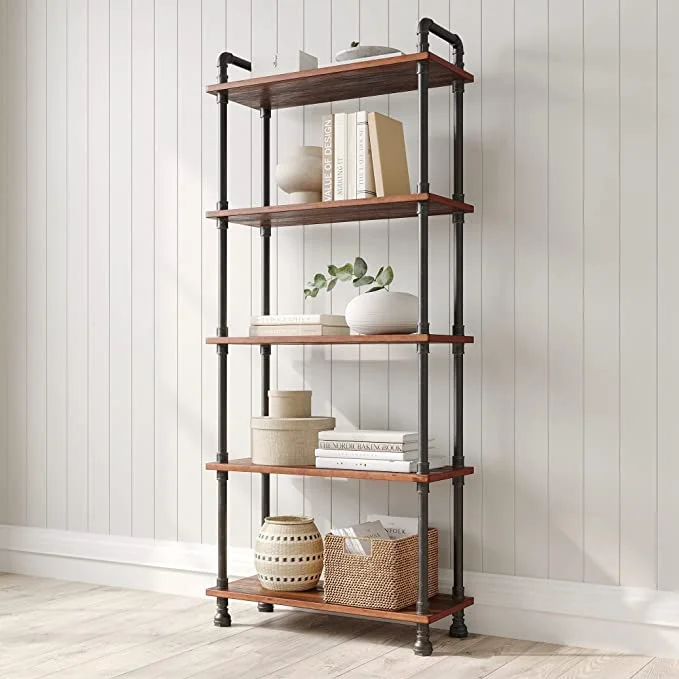Choosing solutions that are strong, fashionable, and reasonably priced might be difficult when furnishing your office. Solid wood furniture may have a timeless appearance that you adore, but the price may be out of your price range. However, even though laminate furniture is less expensive, you can ask if it has the necessary amount of durability.
We have put together a thorough guide about laminate, veneer, and wood furniture in order to assist you in making the best choice. Discover the advantages and disadvantages of each type of material and gather the knowledge you need to make the best purchasing decisions.
What is Laminate?

Laminate is a special kind of material that is long-lasting, inexpensive, and very adaptable. Melamine, a substance that presses layers of sturdy paper together and hardens into a resin, is used in its construction. In turn, a thin ornamental coating can be applied to the resulting solid veneer. The appeal of laminate is that it can practically be printed with any kind of beautiful pattern. Although a wood grain design is frequently employed, there are countless more options. A layer of a transparent protective coating is added as a finishing touch.
The laminate is affixed to a substance known as a substrate to provide strength and structure and produce a finished item that can be used to make durable furniture. Typically, the core of the components is made of fiberboard or particleboard. You have a finished laminate product when all the layers have been added, which may be utilized to make countertops, furniture, etc.
High-Pressure Vs. Low-Pressure Laminate
It’s possible that you’ve noticed that laminate products are divided into two categories: high-pressure laminate (HPL) and low-pressure laminate (LPL). The method of fastening the laminate to the substrate core is described by this term. The laminate is applied to HPL goods using 1,000 to 1,500 pounds of pressure per square inch (psi). Adhesives are utilized to hold everything in place, and the product is heated to temperatures between 280 and 320 degrees Fahrenheit.
LPL goods, on the other hand, are heated to a higher temperature of 335 to 375 degrees Fahrenheit without the need of adhesives. Additionally, only 290 to 435 (psi), as the name suggests, are used. Both procedures result in a robust product, although low-pressure laminates are typically less expensive since they are less expensive to manufacture.
Pros of Laminate Products
Office furniture made of laminate is a common choice, and for good reason.
Some laminate products are antimicrobial, and others are flame retardant. They are a fantastic option for high traffic places like waiting rooms because of this.
They are simple to wash. To keep your furniture in good condition, all you need to do is regularly dust it with a moist microfiber cloth. Pieces made of laminate will continue to seem brand-new for many years to come as long as they are not exposed to direct sunlight.
Laminate furniture is far more scratch- and stain-resistant than solid wood options. An extraordinarily robust product that can resist a demanding workplace is produced during the production process.
Cons of Laminate Products
Despite being high-quality goods, laminates can’t match wood in a number of ways.
Sanding and staining laminates is not possible.
They lack the durability of solid hardwoods.
Others contend that imitation wood grain isn’t as appealing as real wood.
In the end, laminate furniture provides a less expensive option to veneer and solid wood options. Although certain durability trade-offs exist, these goods can be the best option for your office and your budget.
What is Wood Veneer?
A woodworking method that has been used for ages to create distinctive surfaces and intricate inlays of various types of wood is veneer furniture making. Some of the largest names in furniture have created museum-quality pieces with hefty price tags by utilizing various veneering techniques.
These same methods are still used today to create a wide range of office furniture and elegant decorative items. Veneering techniques provide a craftsman with flexibility and room for creativity that wood just cannot match. Furniture made of veneer might be more affordable for those looking for alternatives to real wood.
How is Veneer Office Furniture Constructed?
Office furniture that is produced on a bigger scale often consists of veneer goods, which are made by gluing thin strips of wood that are about 3mm thick onto a base. Core materials include plywood, wood, MDF, and particleboard. A less durable core material will be used in cheaper furniture options.
Pros of Veneer Furniture
a reasonable choice that replicates the appearance and texture of wood. You can still appreciate the beauty of the natural wood grain even though the item won’t be made of real wood.
Veneer furniture can be given a fresh look, though you must be cautious not to remove too much material. Veneer offers a flexible solution, whether you want to polish out a few blemishes and stains or totally alter the piece’s hue.
While veneer furniture cannot match the sturdiness of solid wood and is more prone to warping than wood, it can certainly hold its own. Because of this, pieces with solid wood components and veneer panels are frequently combined.
A craftsman can use veneer to match grains and produce a whole surface from a single tree. With solid wood, this is almost impossible. Additionally, veneers present a chance to create genuinely one-of-a-kind furniture from uncommon wood species and specimens.
All you need to do is use a moist microfiber towel to frequently dust your furniture, and occasionally use furniture polish to keep its brilliance.
Cons of Veneer Furniture
Not made of wood. In the end, veneer items may be attractive, cost-effective, and robust, but they will never be made of solid wood. Some customers find it difficult to accept the possibility that veneer products could compete favorably with wood furniture in many significant categories.
Water damage is possible to veneer. It is possible for moisture to infiltrate under the veneer and loosen the top layer because veneer is attached to the core elements. Buckling and bubbles may be caused as a result. As a result, it’s critical to keep any veneer furniture free from water damage.
Solid Wood Office Furniture
Solid wood office furniture is the most expensive and frequently preferred alternative. Wooden furniture exudes a sense of refinement and authority that can be used to communicate with clients who are just dropping by. Wood might be the finest option for your needs if you have a flexible budget and are seeking for workplace solutions that will last for years to come.
Pros of Wood Furniture
Dependable construction It is difficult to match the lifespan of solid wood furniture in terms of sturdiness. In order to make a truly stable and easily repairable design, wood legs and joints are better able to receive nails, screws, and glue.
Possibilities for stains and colors are practically endless. Wood furniture may be finished in a huge variety of ways, and you can pick the ideal stain to match your office and personal style.
Simple to refinish It is simple to sand and stain wood furniture to alter its appearance or cover a flaw.
Although wood may not be as simple to keep clean and in good condition as laminate items, it is still reasonably simple to maintain. All you need to do is sometimes polish or wax your furniture after dusting it. Your wood furniture can last for many generations if properly maintained.
It is true that purchasing wood furniture requires a larger initial investment. However, there are obvious benefits to investing in long-lasting wood solutions when you consider that wood furniture won’t need to be replaced and that it may be refinished numerous times.
Cons of Wood Furniture
Cost-effective. Although wood furniture has a distinct value, some organizations might not be able to afford the greater cost. Options like laminate and veneer are less expensive and can be more widely available.
Tends to weigh more and be bigger. Although wood furniture is strong and durable, it may also be weighty. If you want to move workplaces or need furniture that is simple to rearrange as demands alter, this can be something to bear in mind.
Vulnerable to warping Although no piece of furniture is fully impervious, wood does have a greater propensity to distort. With flat panels, this is very accurate.
Final Thoughts
The quality of various laminate and veneer products is a subject of many generalizations and urban legends. The fact is that they have a lot of advantages over pricey wood furniture, which may make them more appealing. Everything is dependent on your money and priorities.
To know other construction guides, tips, and methodology for beginners, veterans, and contractors, please see here.
To know the flood prone areas in the Philippines, Top 10 Flood-Prone Areas to Live in the Philippines.
To know more about Concrete Hollow Blocks, Simple Reasons Why Hollow Blocks are Highly Used in the Philippines
To know more about Hammers and Nails, Tips for Guaranteed Best Technique for Hammering Nails

